Legacy Worthy Colours: Colour Flags Trooping of the Color
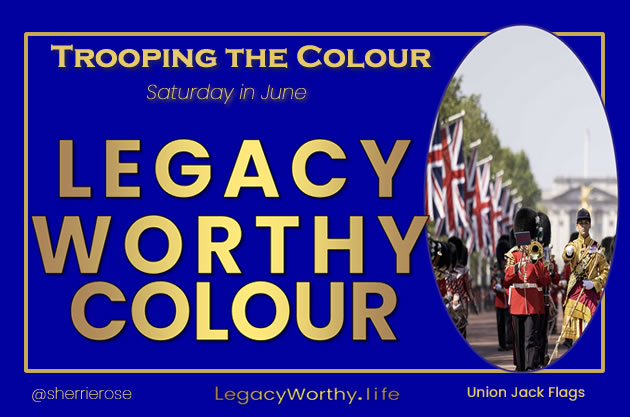
Legacy Worthy Colours: Colour Flag Ceremony Parade called the “Trooping of the Colour”
“Trooping of the Colour” has marked the official birthday of the British Sovereign for over 260 years and the first Trooping of the Colour as we know it today was held for King Charles II in the 17th century. Trooping of the Colour is held mid-June on a Saturday when the weather is good.
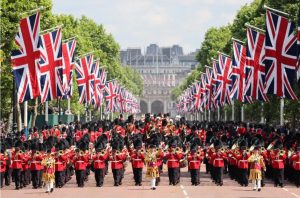
Trooping the Colour
Colour Flags: Trooping the Colour
The regimental flags of the British Army were historically described as ‘Colours’ because the flags displayed the uniform Colours and insignia worn by the soldiers of different army units. The name ‘Colour’ continues to be used to represent flags. The principal role of a regiment’s Colours was to provide a rallying point on the battlefield. This was important because, without modern communications, it was all too easy for troops to become disoriented and separated from their unit during conflict.
If Troops were to know what their Regiment’s Colours looked like, it was necessary to display them regularly. The way in which this was done was for young officers to march in between the ranks of troops formed up in lines with the Colours held high. This is the origin of the word ‘trooping’. This was a vital and practical exercise designed to aid unit recognition before a battle commenced.
The British Army Guards are amongst the oldest regiments and have served as the personal bodyguards of The Sovereign since the monarchy was restored after the English Civil War in 1660.
The ceremony of Trooping the Colour is believed to have been performed first during the reign of King Charles II (1660 – 1685). Later, in 1748, it was decided that this trooping parade would be used to mark the official birthday of the Sovereign and it became an annual event after George III became King in 1760.
Today, Trooping the Colour is a ceremony performed every year in London, United Kingdom, by regiments of the British Army. This spectacular colourful parade and great tradition remains a celebration of the Sovereign’s official birthday. (The current King Charles III actual birthday is November 14th)
Source 1: Trooping the Colour
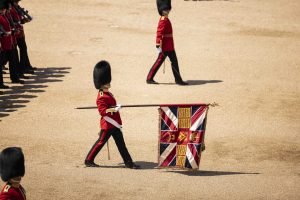
Older than the British Standing Army
For all its popularity and reassuring annual reliability (since 1959, the parade nearly always happens on the Saturday closest to the middle of June, prior to that it was always held on a Thursday) few members of the general public realise the significance that lies behind the stately drill or the original purpose of the parade. The ceremony of Trooping the Colour is older even than the British Standing Army.
In 2023, this impressive display of pageantry will take place on Saturday 17th June by Regiments of the Household Division, on Horse Guards Parade, with His Majesty The King attending and taking the salute.
His Majesty King Charles III will hold the appointment of Colonel-in-Chief of the Regiments of Household Division. Each Regiment has a Colonel who is normally either a member of the Royal Family or a senior officer.
There are three newly appointed Colonels within the Foot Guards:
- Colonel, Grenadier Guards – The Queen Consort
- Colonel, Welsh Guards – The Prince of Wales
- Colonel, Irish Guards – The Princess of Wales
There will be no change to the existing Colonelcies of the other Regiments within the Household Division, which will remain as below:
- Colonel, Blue and Royals – The Princess Royal
- Colonel, Scots Guards – The Duke of Kent
- Colonel, Life Guards – Lieutenant General Sir Ed Smyth-Osbourne
- Colonel, Coldstream Guards – Lieutenant General Sir James Bucknall
Source 2: Trooping the Colour
Trooping the Colour Overview
The Trooping of the Colour has marked the official birthday of the British Sovereign for over 260 years. 2023 will mark His Majesty King Charles III’s first Trooping of the Colour as Sovereign. Over 1,400 parading soldiers, 200 horses and 400 musicians come together each June in a great display of military precision, horsemanship and fanfare to mark The King’s official birthday. The parade moves from Buckingham Palace and down The Mall to Horse Guard’s Parade, alongside Members of the Royal Family on horseback and in carriages. The display closes with an RAF fly-past, watched by Members of the Royal Family from Buckingham Palace balcony
The Sovereign’s birthday is officially celebrated by the ceremony of Trooping the Colour (King’s Birthday Parade). This impressive display of pageantry takes place on a Saturday in June by his personal troops, the Household Division, on Horse Guards Parade, with His Majesty the King himself attending and taking the salute. Over 1400 officers and men are on parade, together with two hundred horses; over four hundred musicians from ten bands and corps of drums march and play as one. Some 113 words of command are given by the Officer in Command of the Parade. The parade route extends from Buckingham Palace along The Mall to Horse Guards Parade, Whitehall and back again.
During the ceremony, The King is greeted by a Royal salute and carries out an inspection of the troops. After the massed bands have performed a musical ‘troop’, the escorted Regimental Colour is carried down the ranks. The Foot Guards and the Household Cavalry then march past His Majesty, and The King’s Troop, Royal Horse Artillery, rank past. The King rides back to Buckingham Palace at the head of his Guards, before taking the salute at the Palace from a dais. The troops then return to barracks. His Majesty then joins other members of the Royal Family on the palace balcony for a fly-past by the Royal Air Force.
The first Trooping the Colour which is reviewed by The Major General usually takes place two weeks before the actual Birthday Parade (June 3rd).
The second Trooping the Colour which is reviewed by The Colonel of the Regiment usually takes place a week before the actual Birthday Parade (June 10th).
Source 3: Trooping the Colour
Source 4: Trooping the Colour
The Foot Guards make up five of the seven regiments in the Household Division and represent all quarters of the United Kingdom – the Scots Guards, Irish Guards, Welsh Guards and the two English Regiments: the Grenadier Guards and the Coldstream Guards.
Trooping the Colour: Unchanged over centuries
This special gift to the Sovereign from his most trusted guardians, the Foot Guards and the Household Cavalry, is steeped in seemingly archaic ritual, unchanged over centuries, is world famous and continues to grow in popularity.
The importance of music
Army musicians play a detailed programme of military marches, many based on popular folk tunes or commemorative marches to assist the troops to get into their positions. The music is chosen in a blind audition held in the Guards Chapel in early Spring. The Director of Music will pitch three alternative tunes for each march on the parade, based on relevance to the regiment trooping their Colour (Welsh Ballads for a Welsh Colour, Irish Gigs for an Irish Colour etc) or to nod to anniversaries, commemorations or special events. So each year’s programme is different to the one that went before. The winning tunes are selected by an expert panel, but the key criterion is always “can we march to this?!”.
The Massed Bands of the Household Division continue to perform music without any repeats throughout the entire parade, and do so without an interval while marching in their own bafflingly complex manoeuvres. The Mounted Band have other challenges. As well as performing their own programme of music they must do so while riding an often-lively war horse, which is a challenge when your instrument of choice is a trombone. Military horses are bred for size, strength and bravery and so don’t make easy mounts for novice riders.
A stage set like no other
Horse Guards Parade provides the perfect stage set for the parade. Surrounded by the great buildings of state from the Admiralty to No 10 Downing St, and to Buckingham Palace in the north, the parade square is dominated by the white stone classical structure of Horse Guards itself, the former HQ of the entire British Army. The Duke of Wellington’s former office is where some members of the Royal Family will gather to watch the parade.
The Royal Procession in glittering gold and silver uniforms makes its way down the Mall to Horse Guards Parade. The Mall is filled with Union Flags and the uniquely red tarmacked road is deliberately designed to look like a VIP red carpet. Announcing the arrival of the procession, the sound of the priceless Georgian Silver kettle drums carried by the Welsh Shire drum horses at the head of the procession filters through to those waiting in the stands on Horse Guards.
Four Divisions of The Sovereign’s Escort of the Household Cavalry, descendants of those loyal gentlemen who protected His Majesty Charles II in exile and accompanied Him back to London to restore the Monarchy in 1660, are still ever present in determined force 365 years later, protecting King Charles III as He rides to Horse Guards to inspect His Troops. It’s an astonishing spectacle of razor steel, mirror groomed horses, tunics of scarlet, blue and gold, swans feathers and silk.
The heartbeat of the nation
Past Commanders have considered the sound of boots on gravel throughout this parade to be the very heartbeat of the nation.
The astonishing array of resplendent uniforms are reminders of past courage and human endeavour, and curiously a very modern way of living, where everything is useful, nothing is wasted and all has purpose.
Within the uniforms on parade, every detail has meaning, whether that is the symbols sewn into collars and cuffs, or the surprisingly practical use of the fanciest decorative items.
Did you know that the gold tips of the fabulously impressive gold aiguillettes (ornamental braided gold cords) worn by some officers on parade could be used to quickly disable an enemy Gun, and the rope act as spare reins for controlling loose horses? Or that The King’s Troop Royal Horse Artillery Busby caps can act as a bucket for watering and feeding horses, the plume doubling up as a shaving brush, and the red flap as a waterproof pocket for protecting documents?
Recycling and repurposing
Most items on parade are antiques handed down through generations or recycled. Some swords date back to the Boer War. Some Bearskin caps have musket ball holes from frontline use in the 19th century. Buttons on red tunics will have been melted down and recast dozens of times.
The parade square is immense, yet every inch is covered by a choreography of battle tactics designed by Wellington to fool Napoleon’s Army at the Battle of Waterloo. Soldiers trained in drone warfare and hi-tech counter insurgency operations are indistinguishable from their forebears a century ago as they work together to move as one then regroup in their individual companies, changing direction and speed in perfect synchronicity.
They do all this seemingly effortlessly, while carrying a heavy rifle, sword, flag or musical instrument in what is often a stress position, and while wearing restrictive uniforms that were designed to protect the wearer in 19th century battle, not designed for comfort. The numerous rehearsals held before the event, some privately outside London, others on the parade square in London, help the body to adapt and it soon all becomes second nature.
Initial challenges when successfully overcome, build resilience, and form precisely the discipline, strength and character required by our military men and women when defending the realm and countering some of the major challenges facing the world today.
Rallying Points
In the very earliest days of land warfare, Colours (regimental flags) were used as rallying points in battle. Each leader had his own device around which his followers assembled and as military organisations developed, it became the natural custom for each company to have its own distinguishing flag. From about 1700 onwards Company Colours were gradually eliminated in favour of battalion Colours, though their original purpose of marking a rallying point, clearly visible above the smoke and dust of battle, remained unaltered.
Under these conditions, it became the practice to carry the Colours down the ranks at the end of a day’s march and to escort them with due pomp to the billet in which they were to be lodged for the night. This lodging, normally the headquarters of the unit was, in effect, the alarm post on which the battalion would assemble in cases of emergency.
Recognition and identity
The object of the ceremony was at first to ensure that every soldier was well acquainted with the distinguishing device of their own unit and secondly to make certain that all ranks were aware of the place of assembly in a strange town. On arrival at the lodging, the Colours were normally hung from a doorway or window to mark the battalion headquarters and alarm post.
In the morning, the Colours were solemnly escorted from the billet to their place in the ranks of the battalion. As a result of these ceremonies, the Colours gradually came to represent the spirit of the regiment and, as such, special respect was paid to them.
Originally, the parade was known as “Lodging the Colours” but, in detail, it differs little from the modern trooping ceremony. In the past all colours of the regiment (until 1743 British units had three each) were “Trooped”, but today the honour is reserved for The King’s Colour only.
In 2023, King Charles took part in Trooping the Colour on horseback, the first time a sovereign has done so since Queen Elizabeth II’s last outing in 1986. Trooping the Colour saw over 1,400 parading soldiers, 200 horses and 400 musicians in a great display of military precision, horsemanship and fanfare. They processed from Buckingham Palace down the Mall the Horse Guards Parade, passing by thousands of well-wishers, many of whom were waving flags. Members of the Royal Family also take part, with Prince Edward, Prince William and the Princess Royal joining the King on horseback.
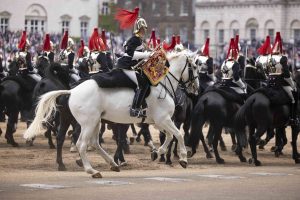
Something for all the family
It is this grand ritual of identity and belonging that is played out in Trooping the Colour for The King’s Birthday, and the whole regimental family is present to witness it from all seven regiments of the Household Division, including all the Regimental Colonels, some of whom are senior members of the Royal family. Such is the importance of the parade the Prime Minister and senior representatives of the Commonwealth and allied nations will also attend.
It is known that the entire Household Division carried out a Trooping the Colour parade as early as 1755 and at a later period it was regularly performed when important guards were mounted and dismounted and also at Retreat. It was in 1805 that the custom of Trooping the Colour to honour the Sovereign’s Birthday was initiated, though it was in abeyance from 1811 until 1820 owing to the illness of King George III. The ceremony was revived on the accession of King George IV and has continued since then. During King William IV’s reign the Colour was also “trooped” to celebrate The Queen’s Birthday.
What is today a major ceremonial occasion stems from strong historical associations which connect it with the daily duties of Britain’s first disciplined Army. Only one Colour can be trooped at any one time, so the five regiments of Foot Guards: Grenadier, Coldstream, Scots, Irish and Welsh Guards take it in turns to do so annually. The regiment to have the honour to troop its Colour for the following year is chosen at the Colonel’s dinner the night before the Troop, which is hosted by the Senior Colonel of the Household Division, currently HRH The Princess Royal.
Trooping the Colour is almost never cancelled. In the last hundred years it was cancelled in 1926 due to the General Strike, in 1948 due to the weather, and in 1955 due to a National Rail Strike. There was no King’s Birthday Parade from 1940 – 1946 inclusive due to the Second World War. Even the COVID-19 Pandemic could not stop it. The Welsh Guards performed a small, redesigned, socially distanced, ceremony for Her Majesty The Late Queen at Windsor Castle in 2020, and The Scots Guards performed a mini Trooping also at Windsor in 2021, due to COVID-19 restrictions. In 2022 the Parade returned to Horse Guards but in May and on a Thursday to coincide with the anniversary of HM The Late Queen’s Coronation and Her Platinum Jubilee.
Source 5: Trooping the Colour
Trooping The Colour: Chronological order of the parade ceremony
The chronological order of the parade:
1. March on
Before The King’s Birthday Parade starts, a number of Colour Sergeants and Sergeants will take position as Colour Points to guide the troops to their correct positions on Horse Guards Parade.
The six Guards arrive and form up, accompanied by the Massed Bands and followed by The King’s Troop Royal Horse Artillery.
The Colour Party of one Colour Sergeant and two Guardsmen, hand-picked for the role, marches to the centre of Horse Guards Parade and takes post forward left of Number Six Guard.
The Duty Drummer then marches out and uncases the Colour, ready for it to be Trooped.
The Adjutant of the Parade hands over command to the Field Officer in Brigade Waiting (Commanding Officer, 1st Battalion Welsh Guards), who orders the Officers to fall in.
After a pause, Number Three Guard will open outwards from the centre to prepare for the arrival of carriages conveying Members of the Royal Family.
As Members of the Royal Family arrive, the Guards Present Arms, The King’s Troop Carry Swords and the Massed Bands play six bars of the National Anthem as a Royal Salute.
The carriages enter Horse Guards Arch, where the occupants alight to watch the parade from the Major General’s office, which was once that of the Duke of Wellington.
2. Arrival of the Sovereign
The Royal Procession is led by the Household Division Brigade Major, Lieutenant Colonel James Shaw. The Sovereign’s Escort, found by troops of the Household Cavalry and the Mounted Band, protect His Majesty in the Royal Procession from Buckingham Palace to Horse Guards Parade. Two Divisions of the Sovereign’s Mounted Escort travel ahead of His Majesty and two Divisions travel behind.
His Majesty The King is accompanied on the event by the Royal Colonels of the Regiments, currently –
- Her Royal Highness The Princess Royal (Colonel The Blues and Royals)
- Her Majesty The Queen (Colonel Grenadier Guards)
- His Royal Highness The Duke of Kent (Colonel Scots Guards)
- Her Royal Highness The Princess of Wales (Colonel Irish Guards).
- His Royal Highness The Prince of Wales (Colonel Welsh Guards)
- His Royal Highness The Duke of Edinburgh (Colonel London Guards)
Also part of the Royal procession are:
Major General Sir Edward Smyth-Osbourne (Colonel The Life Guards), Lieutenant General Sir James Bucknall (Colonel Coldstream Guards), The Major General Commanding The Household Division, The Chief of Staff HQ London District, the Aide-de-Camp, the Silver Stick-in-Waiting, and the Foot Guards’ Regimental Adjutants.
As His Majesty arrives at precisely 11 am, a Royal Salute is given, the National Anthem is played and the Royal Standard is flown from the roof of Horse Guards.
3. Inspection of the line
His Majesty The King conducts his inspection of the Foot Guards who, along with the Household Cavalry, form the Household Division. Every Guardsman on parade is an operational soldier and standards they apply to ceremonial duties are reflected in the excellence with which they conduct operations. With more experience of this event than any other person present, His Majesty who has frequently ridden in parade in His prior role of Colonel Welsh Guards will notice any detail that is not correct and will inform the Major General afterwards.
Once His Majesty The King has returned to the saluting base, the command ‘Troop’ is given by the Field Officer in Brigade Waiting.
4. Massed Bands Troop
The Massed Bands and Drums march across Horse Guards Parade in slow and quick time. The slow march is, by grand tradition, Giacomo Meyerbeer’s opera ‘Les Huguenots.’
The Massed Bands and Drums then reposition to allow the Escort for the Colour room to march forward.
A Lone Drummer peels off and takes up a position two paces to the right of the Escort. Drummers form either the Machine Gun or Assault Pioneer Platoon in training and on operations, depending on the requirements of their Battalion.
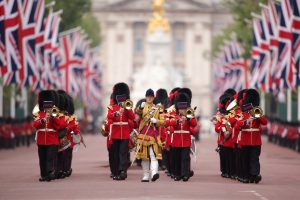
5. Collection of the Colour to be trooped by the Escort (The Prince of Wales’s Company, Welsh Guards)
The Lone Drummer plays eight bars of a field signal called ‘The Drummer’s Call,’ prompting the Captain of the Escort to transfer its command to the Subaltern.
The Escort is moved into close order, ready to march forward to collect the Colour. The Regimental Sergeant Major is positioned at the rear of the Escort.
The Regimental Sergeant Major gives his pace stick to his Orderly then draws his sword, the only occasion a Warrant Officer does so on parade.
The Subaltern, followed by the Ensign (the junior officer tasked to carry the Colour), leads the Escort forward in quick time towards the Colour Party.
The tune of ‘The British Grenadiers’ is played regardless of which Regiment is Trooping its Colour as all infantry Battalions once included a Grenadier Company. The Grenadier Company was made up of the tallest men in a Regiment and stood on the right of the Line, tactically the most important position on the battlefield.
The Escort halts in front of the Colour Party. The Regimental Sergeant Major passes the Colour to the Ensign who places it in his white Colour Belt and turns about to face the Escort.
The ‘Escort for the Colour’ now becomes the ‘Escort to the Colour’ and Presents Arms to its Colour while the Massed Bands play the National Anthem. The four Non-Commissioned Officers at the corners of the Escort turn outwards and Port Arms to protect the Colour and Escort during this Salute.
The Regimental Sergeant Major and others return to their positions and with the Ensign and Colour to the front, the Escort slow marches towards Number Six Guard.
The Massed Bands perform a spin-wheel to enable them to turn smartly and efficiently in a limited amount of space. This movement is not written down in any drill manual but is passed down from one generation of musicians to the next by word of mouth.
6. Trooping the Colour through the ranks in slow time
The Field Officer in Brigade Waiting orders the entire parade to Present Arms in order to pay appropriate compliments to the Colour.
The Escort Troops the Colour along the ranks of the other Guards, starting at Number Six Guard and finishing at their own position at the right of the Line.
Once the Escort has returned to its position, the Captain resumes command. The Parade is ordered to Slope Arms, completing the Trooping phase.
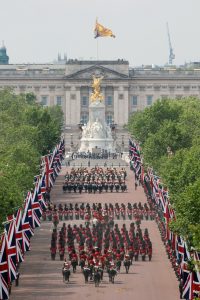
7. March past by Foot Guards in slow and quick time
The Guards turn about and form into Column, transforming the long unbroken lines of Guardsmen into a number of evenly spaced formations, ready to manoeuvre.
The Guards march around Horse Guards Parade in slow time. Maintaining dressing in straight lines and the correct column distance between Guards takes much practice to achieve.
As the Escort and each Guard pass His Majesty, the music changes to the respective slow march of the Regiment. Officers Salute with their swords and other ranks give a sharp Eyes Right.
The Ensign carrying the Colour Salutes by lowering it to a horizontal position, completely unfurled, with the Regiment’s insignia and battle honours fully visible.
His Majesty acknowledges the Colour as it passes, while the Royal Colonels and other senior Officers Salute.
Once every Guard has passed His Majesty in slow time, they break into quick time.
Once again, the Guards march past His Majesty, this time to their respective Regimental quick march. The Ensign carrying the Colour remains at the rear righthand side of the Escort.
On completion of the march past in quick time, the Guards form back into Line in their original positions and halt as the music cuts out.
The Massed Bands withdraw to allow the Band of the Household Cavalry to come forward for the ride past.
8. Ride past by The King’s Troop Royal Horse Artillery and the Household Cavalry
The King’s Troop Royal Horse Artillery, The Life Guards and The Blues and Royals (Royal Horse Guards & 1st Dragoons), ride past His Majesty accompanied by music provided by the Mounted Band of the Household Cavalry.
The King’s Troop leads the Divisions because the guns of the Royal Horse Artillery take precedence over all other units when on parade.
The Sovereign’s Standard is dipped to His Majesty at the walk past by the Standard Bearer.
For mounted troops, marching past is conducted at the Walk and the Sitting Trot. Changes of direction by the Cavalry are given by ‘cutting’, a flashing sword movement, not by voice.
The music played for the Sitting Trot is the tune of ‘The Keel Row.’ The horses know this tune and will prick up their ears as soon as the first few bars are played.
Note that soldiers in The King’s Troop all have operational roles in the Royal Artillery, either with guns in the indirect fire role or operating Unmanned Aerial Systems. Household Cavalry soldiers are all trained to operate in the Armoured Cavalry role, currently with the CVR(T) vehicle and soon to be equipped with the new Ajax vehicle.
9. March off
After the Household Cavalry rides past, the National Anthem is played as His Majesty The King receives the final Royal Salute. The Field Officer in Brigade Waiting informs His Majesty that His Guards are ready to march off. His Majesty gives permission for them to do so and the Field Officer withdraws. The Guards form Divisions in six ranks and close up together as the Mounted Troops leave the Parade. His Majesty, flanked by the Royal Colonels, moves to the head of His Guards for the procession along The Mall to Buckingham Palace. Preceded by the Household Cavalry, the Massed Bands lead the Royal Procession along The Mall. The Street Liners give a Royal Salute as His Majesty passes. Once His Majesty and the Guards have departed Horse Guards Parade, the Colour Points march off, signifying the end of the parade at Horse Guards.
10. After The Ceremony
On arrival at Buckingham Palace, His Majesty The King takes post at Centre Gate of the Forecourt with the Field Officer in Brigade Waiting on his left.
Falling in behind His Majesty inside the Forecourt are the Regimental Colonels, the Major General, Silver Stick, the Chief of Staff HQ London District, the Brigade Major of the Household Division and the Aide-de-Camp to the Major General.
The front Division of the Escort to the Colour peels off and enters Buckingham Palace Forecourt by North Centre Gate to prepare for the daily Changing of the Guard ceremony, which now takes place.
The New Guard is found by the Escort to the Colour while the Old Guard is found this year 2023, by Number 12 Company Irish Guards who have guarded His Majesty for the previous 24 hours.
All remaining Guards march past His Majesty and give an Eyes Right as they do so, before returning to Wellington Barracks to be dismissed.
As soon as all Guards have marched past, the Mounted Troops, led once again by The King’s Troop Royal Horse Artillery, will Rank Past His Majesty from a holding area in Spur Road. The King’s Troop Royal Horse Artillery then makes its way to Green Park and the Sovereign’s Escort makes its way to Hyde Park Barracks, followed by the Mounted Band of the Household Cavalry, where they are dismissed.
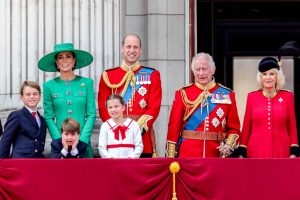
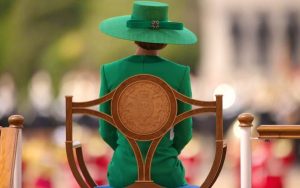
Gun Salutes
The King’s Troop fires a 41-gun salute in Green Park at 12:52pm to mark His Majesty’s official birthday. A second salute of 62 guns is fired at His Majesty’s Palace and Fortress, The Tower of London by the Honourable Artillery Company, the City of London’s Army Reserves.
His Majesty, having entered Buckingham Palace after the March and Rank Past, will appear on the balcony of Buckingham Palace with other Members of The Royal Family in attendance to view the Royal Air Force fly past at 1 pm, marking the end of the King’s Birthday Parade in its entirety.
The world is watching
Everyone who takes part glows when they recall their first Trooping the Colour. It brings back memories of personal pride and satisfaction, it’s a genuine career highlight. Yet delivering The King’s Birthday Parade is considered one of the most challenging things a soldier can do in their career, and many experienced soldiers say frontline combat operations are easier than performing on what is essentially a global stage where every minor flaw is all too visible and there’s nowhere to hide. But nothing can beat the feeling of marching immaculately in front of the Monarch, the Colonel in Chief; families and friends in the stands; and the world watching on TV and streaming over the internet. How to Watch Trooping the Color
8,000 coveted seats in the stands around the parade square
Each year, at least 250,000 people apply for a place in the ballot that decides who will get one of the 8,000 coveted seats in the stands around the parade square. The fairness of that process means The King’s Birthday parade is attended by a complete cross section of modern society, many coming from across the Commonwealth, and all ages, but all united in their love of live spectacle.
Many tens of thousands more will get up at dawn to claim a pitch by The Mall or in The Royal Parks on the day to try and catch a glimpse of The Royal Procession which is such an impressive part of the parade.
The entire event with activity from 10am to 1pm is broadcast live globally, using footage provided by the BBC Events Team, and is a significant media highlight in more than fifty countries each year, with live commentary in dozens of native languages. It is also one of the most accessible events in the calendar with the technology of the BBC’s famous red button there is accessible commentary for the blind and partially sighted and then on the BBC i-Player there is a live signed version of the broadcast and another version offering images without commentary for purists.
The biggest challenge of your career
British Army soldiers are fit and tough, but even they find this parade physically extremely challenging because of the extraordinary length and nature of the parade. The parade which starts and ends at Buckingham Palace lasts for around two hours though in reality soldiers will spend much longer on their feet getting into position and preparing the ground. It is mentally challenging because the parade is unique in format, and it involves many complex drill moves – some of which aren’t written down but have been passed down orally through generations of Sergeant Majors through the centuries; 113 words of command given by the Officer in Command of the Parade have to be remembered by heart. If you listen carefully you can hear some soldiers counting ceaselessly under their breath to keep time and step, aided by the regular beat and signal of the Corps of Drums.
If you can see yourself as part of a future King’s Birthday Parade, click here.
Source 6: Trooping the Colour



